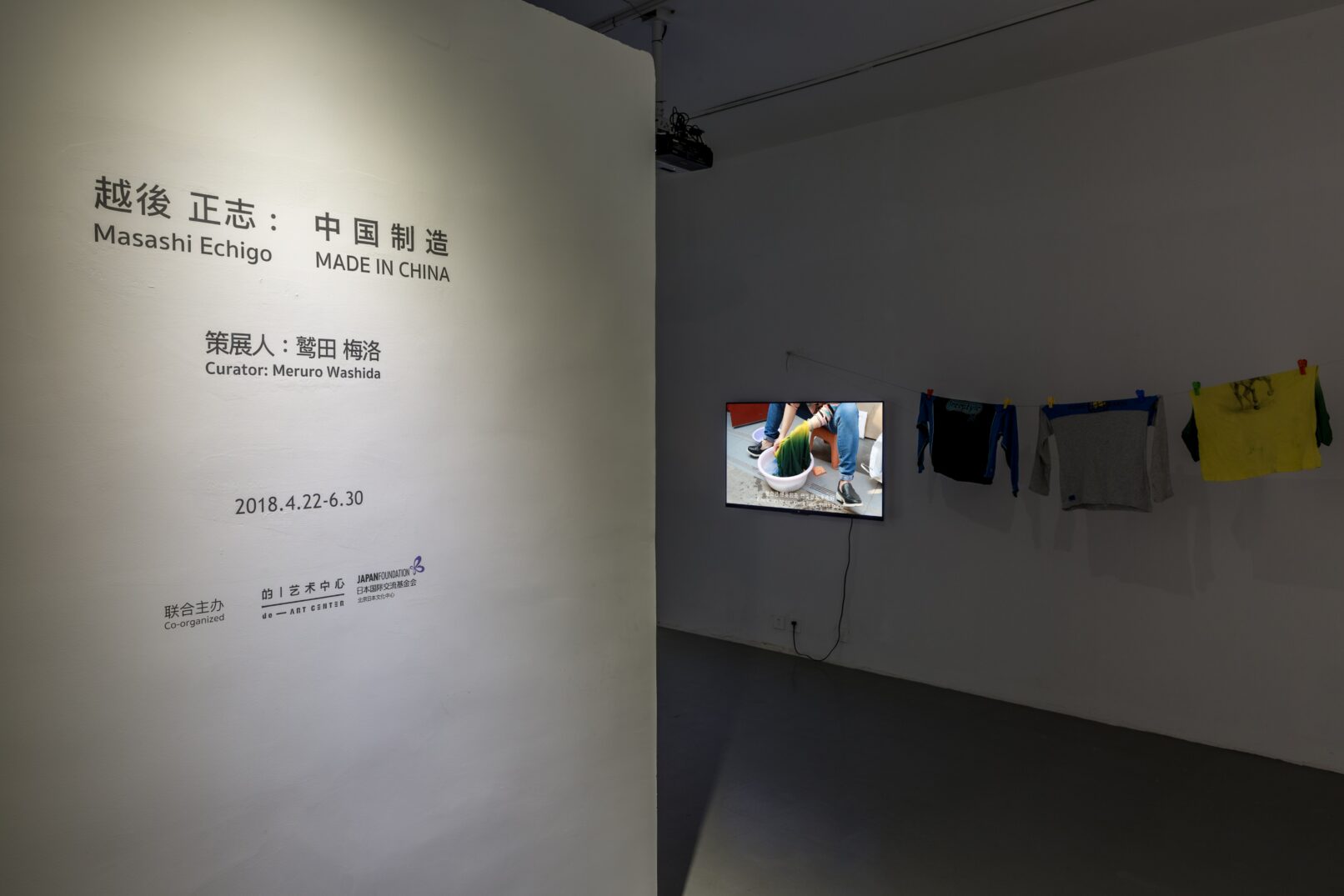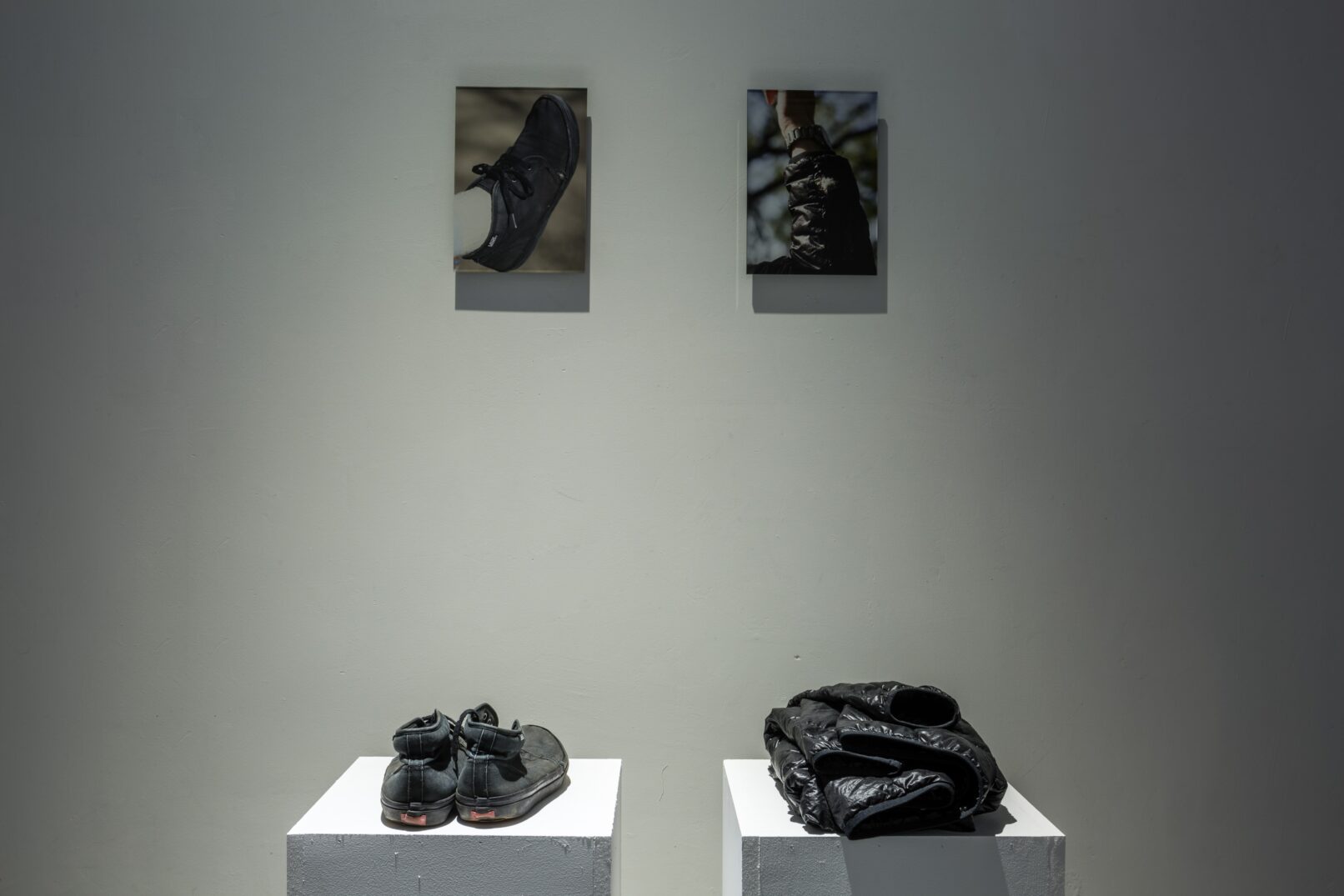越後正志是1982年出生于富山县高冈市的日本艺术家。现以东京和香川县小豆岛为活动据点。此前,越後曾在许多地方居住过,如伦敦、鹿特丹、肯特、巴黎等地。“移动” 是越後作品的中心主题,这与越後的经历有关。他曾作为异乡人在不同的土地上居住过。在举办展览的地方,与当地的人与物相遇,由此展开作品的创作,这是越後的创作风格之一。
本次在 的|艺术中心 举办的个展也是如此。越後抵达北京后,通过介绍在艺术中心附近见到裁缝,以此为灵感创作了新作品。
个展 “中国制造” 上的展出作品以这位裁缝为主题,是由影像、声音、物品构成的装置艺术。作品由3个故事组成。
1. 高冈-北京
越後的工作服和工作鞋在日本经过长时间使用,有了几处破洞。在个展的影像中,展示了裁缝修补工作服和工作鞋的过程。墙上挂着在日本拍摄的磨损衣物的照片,展示台上陈列着在北京修补好的衣服。
实际上,这些衣服全部都是中国制造,但越後并不是故意选择了中国制造的衣服。明治时期(19世纪70年代)以来,纺织业曾是日本的核心产业,服装也曾是日本的主要出口产品。如今,生产基地向劳务成本更低的中国和东南亚转移,日本的平价衣物几乎全部依赖进口。当越後来到中国进行创作时,将长时间无意识使用的日用品,有意识地将其视为从中国来到日本的物品。越後将中国出口到日本的衣服,再次带回到中国,请中国的裁缝将其修补完好。
2. 芜湖-北京
帮越後修补衣服的裁缝是北京的外来务工者。27年前,她从芜湖来到北京。相比家乡,她在北京生活的时间更长。她在北京安家立业,也在北京将孩子养育成人。越後在裁缝家听其讲述了自己的故事。展厅里播放的正是这段叙述。此外,厅内还展出了一些 “傻子瓜子”。她说,这是她故乡的特产,幸好在北京也能尝到,成了她这异乡人的心灵慰藉。在北京,有许许多多背井离乡的外来务工人员。可以说,是他们在支撑着北京的快速发展,但过于密集的人口也成为这座城市的问题。政府为减少人口出台了相关政策,而这也直接影响到她的生活。
3. 北京-洛杉矶
这位裁缝的儿子曾就读于北京的一所国际高中,毕业后赴美国宾夕法尼亚念大学。最近,他已经毕业并留在洛杉矶工作。他虽生于北京,长于北京,但由于所持的是芜湖户口,不仅无法在北京的高中入学,由高考考入北京的大学也有诸多不便。在中国出生、在美国生活的他也是某种意义上的 “中国制造” 之一。他的家中尚留有他从前的衣服。他的裁缝母亲将这些衣物洗净后交予越後,于展厅之内晾干。20年前,她所做的工作基本是缝制衣物,随着时代变迁,如今她的工作渐渐变成以洗涤为主。
越後自身以及与其相遇之人的移动轨迹,都在越後的作品中交叠重合着。面对不断变化的社会,越後自身也在步履不停地去贴近每个人琐碎的日常生活。他所聚焦之处,为我们展示了城市政策之下、大众媒体当前,作为生活之道的艺术所蕴含的可能性。
— 策展人 鹫田梅洛
Masashi Echigo was born in 1982 in Takaoka, Toyama Prefecture, and he currently lives and works in Tokyo and Shōdoshima. Echigo previously lived in several places, including London, Rotterdam, Ghent and Paris. Movement is a central theme in Echigo’s art, a theme that is related to his experience. Echigo has lived in many different locations as an outsider. In the places where he holds exhibitions, one of his creative methods involves interacting with the local people and creating new work from there.
This is also true of his current solo show at de Art Center. After Echigo arrived in Beijing, the Art Center introduced him to a seamstress nearby, which inspired him to make new work.
The works presented at “Made in China” is focused on this seamstress. It is an installation of video, sound, and objects, comprised of three stories.
1. Takaoka – Beijing
Masashi Echigo had been using his work clothes and shoes in Japan for a long time, and there were a hole in these each items. The video shown here presents the process of a seamstress mending these work clothes and shoes. Pictures of the worn clothing taken in Japan, as well as the clothing itself, after being mended in Beijing, will also be shown.
All of this clothing was made in China, though Echigo did not consciously choose it for that reason. Since the Meiji period (after the 1870s), textiles were a core industry in Japan, and textile was one of Japan’s primary exports. These bases of production have since moved to China and Southeast Asia, where labor costs are lower, and almost all bargain clothing in Japan is imported. When Echigo came to China to make the work, he took everyday articles that he had used unconsciously for so long and began consciously seeing them as objects brought from China to Japan. Echigo took clothing exported from China to Japan and brought it back to China, and had a Chinese seamstress make them whole again.
2. Wuhu – Beijing
The seamstress who helped Echigo mend the clothes was a migrant worker in Beijing, who had moved from Wuhu 27 years ago. She has lived in Beijing longer than she did in her hometown. She has established a home and a business in Beijing, and she has also raised children to adulthood in the city. While at her home, Echigo listened to her tell her story, which is played for viewers in the exhibition space. Some “Fool’s Sunflower Seeds” are also placed in the space. She said that this was a product of her hometown. Fortunately, she can find them in Beijing, and they have become a source of comfort for her. Beijing is currently host to numerous migrant workers who have left their hometowns. They have supported Beijing’s rapid development, but population density has become an issue in Beijing. The government has announced various policies to reduce the city’s population, which have directly impacted her life.
3. Beijing – Los Angeles
The seamstress’ son attended an international high school in Beijing, and after he graduated, he went to Pennsylvania for university. He has recently graduated and decided to stay in Los Angeles in United States to work. Although he was born and raised in Beijing, due to his Wuhu household registration, he could not attend a public high school in Beijing. Taking the Chinese college entrance exams for Beijing universities would also have been very difficult. He was born in China and lives in the United States, so he was also “Made in China” in a sense. He left some of his clothing in his mother’s home. His seamstress mother washed these clothes and gave them to Echigo to hang in the exhibition space to dry. Twenty years ago, most of her work was making clothes, but times have changed, and most of her work is now washing.
The movements of the artist and the people he meets are layered in his work. In confronting a constantly changing society, Masashi Echigo has always approached the trivial details of people’s everyday lives. This way of looking at the society, is opposite to the way of thinking of city policies. He focused on showing us the possibilities of art as a way of life.
– Meruro Washida, curator
















